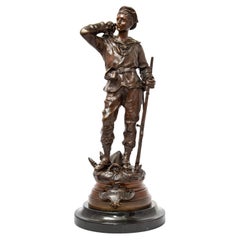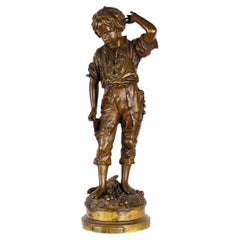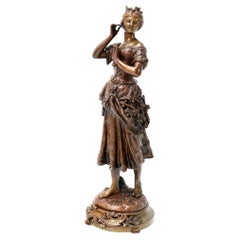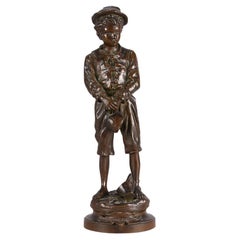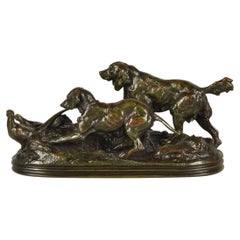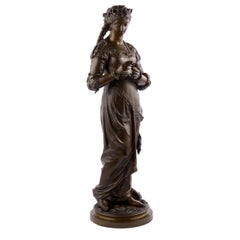Charles Anfrie Decorative Objects
5
to
4
5
5
5
2
5
Height
to
Width
to
5
5
5
4
1
2
1,317
740
492
448
Creator: Charles Anfrie
A Patinated Bronze Figure of a Marine, after the original by Charles Anfrie
By Charles Anfrie
Located in 263-0031, JP
The French sculptor Charles Anfrie (1833-1905) created a number of pieces on martial themes. This work, bearing a cartouche reading “Après le Combat,” shows what I surmise is a Frenc...
Category
Early 19th Century French Antique Charles Anfrie Decorative Objects
Materials
Bronze
19th Century French Bronze Sculpture entitled An accident by Charles Anfrie
By Charles Anfrie, Vrai Bronze B.D.
Located in Lisbon, PT
A Charles Anfrie (Catalan sculptor Charles Anfrie, 1833-1905) bronze statue of a boy
“C. Anfrie” signed with “ Vrai Bronze Garanti. Paris. BL” caster seal and titled 'Un accident' ...
Category
19th Century French Napoleon III Antique Charles Anfrie Decorative Objects
Materials
Bronze
Late 19th Century Art Nouveau Bronze Retour Des Cerises by Charles Anfrie
By Charles Anfrie
Located in Amsterdam, NL
Stunning and rare Late 19th Century Art Nouveau sculpture.
Design by Charles Anfrie.
Striking French design from the 1890s.
This wonderful Late 19th Century Art Nouveau sculpture by Charles Anfrie is executed in patinated bronze and signed at the base with Retour Des Cerises.
This attractive young girl walks away happy after picking...
Category
1890s French Art Nouveau Antique Charles Anfrie Decorative Objects
Materials
Bronze
Antique Bronze Street Urchin by Charles Anfrie, 1833-1905', 19th Century
By Charles Anfrie
Located in London, GB
This is a large Spanish bronze sculpture of a street urchin by the renowned Catalan sculptor Charles Anfrie, 1833-1905 and Circa 1890 in date.
The s...
Category
1890s Spanish Antique Charles Anfrie Decorative Objects
Materials
Bronze
Late 19th Century Art Nouveau Bronze Entitled "Broken Jug" by Charles Anfrie
By Charles Anfrie
Located in London, GB
A very fine late 19th century bronze figure of a young lad dressed in period attire holding a broken jug, with excellent rich brown patina and fabulous hand finished surface detail, signed & titled
ADDITIONAL INFORMATION
Height: 20 cm
Condition: excellent original condition
Circa: 1890
Materials: Bronze
SKU: 8279
ABOUT
Charles Anfrie...
Category
1890s French Art Nouveau Antique Charles Anfrie Decorative Objects
Materials
Bronze
Related Items
Mid-19th Century French Bronze Entitled "Deux Chiens en Arret" by A L Barye
By Antoine-Louis Barye
Located in London, GB
"Deux Chiens en Arret" by A L Barye
A dramatic mid 19th Century French bronze animalier group of a pointer and setter as they iflushing pheasants in a naturalistic undergrowth. The bronze with excellent autumnal (green, brown, and orange) patina and intricate hand chased surface detail, signed Barye. A rare bronze subject from the artist’s own atelier (workshop).
Additional information
Measures: Height: 12 cm
Width: 25 cm
Depth: 8 cm
Condition: Excellent Original Condition
Circa: 1860
Materials: Bronze
Book Ref BARYE Catalogue Raisonne des Sculptures by
Michel Poletti – Alain Richarme
Page no. 150
Description
Antoine Louis Barye
“The Michelangelo of the Menagerie”
These are the words of Théophile Gautier in praise of Barye’s genius. Throughout his life Barye endeavoured to capture the fundamental nature of the animal kingdom in all its diversity, wild or tame, exotic or familiar, cruel or gentle, bringing to life the roaring, trembling, living beasts.
The son of a goldsmith, apprenticed to a steel engraver at a young age, Barye found himself making moulds for ornaments, acquiring knowledge that he would later build on to produce his exquisitely chased bronzes. When he was called up at seventeen, he joined the army’s topographic brigade where he used clay to model raised relief maps...
Category
Mid-19th Century French Art Nouveau Antique Charles Anfrie Decorative Objects
Materials
Bronze
H 4.73 in W 9.85 in D 3.15 in
Patinated Bronze Sculpture/Figure of a Frog
Located in Guaynabo, PR
This is a patinated bronze medium size sculpture of a sitting frog with its right hand in the chest (it’s heart). This gesture symbolizes dignity and hono...
Category
20th Century Unknown Modern Charles Anfrie Decorative Objects
Materials
Bronze
French Late 19th Century Animalier Bronze "Tortue" by Antoine L Barye
By Antoine-Louis Barye
Located in London, GB
A delightful mid 19th Century French bronze figure of a tortoise with excellent hand chased surface deail and very fine fine rich brown patina rubbed to a golden hue in areas, raised...
Category
Mid-19th Century French Art Nouveau Antique Charles Anfrie Decorative Objects
Materials
Bronze
Charles Korschann Art Nouveau Gilt Bronze Nude
By Charles Korschann
Located in Dallas, TX
Charles Korschann Czechoslovakian
Art Nouveau Gilt-Bronze Figural Bud Vase. Cast from a model by Charles (Karl) Korschann, circa 1899, of urn form, with a handle in the form of a...
Category
1890s Czech Art Nouveau Antique Charles Anfrie Decorative Objects
Materials
Bronze
Late 19th Century Bronze Cocker Spaniel
Located in Forest Row, East Sussex
A late 19th century cocker spaniel holding a toy in it's mouth. Bronze.
Category
Late 19th Century English Antique Charles Anfrie Decorative Objects
Materials
Bronze
19th Century Animalier Bronze Sculpture entitled "Falcon" by Jules Moigniez
By Jules Moigniez
Located in London, GB
An excellent mid 19th Century French Animalier bronze study of a falcon perched on a branch using its outspread wings to balance and with its beak open. The bronze exhibiting excellent intricate hand chased surface detail and very fine rich brown lightly rubbed patination, signed J Moigniez.
ADDITIONAL INFORMATION
Height: 23 cm
Width: 23 cm
Condition: Excellent Original Condition
Circa: 1870
Materials: Bronze
Book reference: Animals in Bronze by Christopher Paine
Page no. 79
SKU: 9000
ABOUT
Jules Moigniez (French, 1835 ~ 1894) Moigniez was a French animalier sculptor of the 19th century. He worked primarily in bronze and frequently exhibited his sculptures at the Paris salon. He was best known for his bronzes depicting birds, although his skill and versatility enabled him to produce quality horse sculptures (primarily racehorses), dog sculptures and hunting scenes. His bird sculptures were among the finest ever created in his time. Moigniez was born at Senlis, Oise, France in 1835, the son of a metal gilder. Moigniez’s father bought a foundry to cast his sculptures, which was of great benefit to Moigniez as he didn’t have the added foundry costs that most of his contemporaries had to pay. Moigniez studied sculpture under the tutelage of Paul Comoléra (a student of François Rude) in Paris. It is quite likely that Moigniez’s attraction to bird sculpture was a direct result of his education under Comoléra, who was himself a bird specialist. Over the course of his 40-year sculpting career Moigniez exhibited thirty works at the Salon between 1855–92. His first submission in a major art exhibition was his plaster, Pointer Stopping at a Pheasant, at the Exposition Universelle of 1855.[1][2] Moigniez was known for the fine detail and chiseling of his sculptures. His bronzes—usually cast using the lost wax method—were always immaculately chased and patinated, and were especially popular in England and Scotland.[2] More than half of his output during his lifetime was sold in the United Kingdom. By the end of the 19th century, his sculpture had become popular in the United States as well. In contrast with other animaliers of the period such are P.J. Mêne and Antoine-Louis Barye, Moigniez’s bird sculptures often incorporated highly detailed bases complete with bushes, extensive foliage and undergrowth. His castings were generally of excellent quality with a variety of patinas, the gilded and silvered patinas being the most desirable and sought after by collectors. His bronzes could be reproached for an excess of detail, a result of overly-finicky, over-worked chiseling. Moigniez received redemption, however, by portraying in his sculpture a certain “elegance of attitudes”. His Chien braque...
Category
Mid-19th Century French Art Nouveau Antique Charles Anfrie Decorative Objects
Materials
Bronze
H 9.06 in W 9.06 in D 7.88 in
Orientalist Patinated Bronze Figure of a Turkish Young Man
Located in North Hollywood, CA
Moorish Turkish man dressed in Ottoman Empire-style costume and turban.
An orientalist Moorish patinated cast bronze figure of a standing guard on stand.
(Missing something in his ha...
Category
Mid-20th Century French Moorish Charles Anfrie Decorative Objects
Materials
Bronze
19th Century Art Nouveau Bronze Sculpture of a Female Hen by A. Grevin & F. Beer
By Alfred Grevin
Located in Buenos Aires, Olivos
19th century Art Nouveau silvered bronze sculpture of female hen by A. Grevin & F. Beer.
Women Dressed as a Hen, she has a basket of eggs. On circular base incised " A. Grevin et Be...
Category
Late 19th Century French Art Nouveau Antique Charles Anfrie Decorative Objects
Materials
Bronze
Antique Painted Spelter Metal "La Toupie" Statue Figure after Charles Anfrie
Located in Philadelphia, PA
Antique painted spelter metal "La Toupie" statue figure after Charles Anfrie. Item features painted spelter figure of a boy with his top, possibly made ...
Category
Early 20th Century Charles Anfrie Decorative Objects
Materials
Metal
Late 19th Century Art Nouveau Bust Entitled "Lola" by Emmanuel Villanis
By Emmanuel Villanis
Located in London, GB
Stunning Art Nouveau bronze bust depicting the character "Lola" modelled in the midst of an inquisitive look. The study has a multi hued patination of colours that accentuate the very fine hand chased surface detail. Signed ?E Villanis...
Category
19th Century French Art Nouveau Antique Charles Anfrie Decorative Objects
Materials
Bronze
19th Century Animalier French Bronze Entitled "Taureau Debout" by Rosa Bonheur
By Rosa Bonheur
Located in London, GB
"Taureau Debout" by Rosa Bonheur.
An excellent late 19th Century French animalier bronze study of a standing bull with fine hand chased surface that accentuates the muscle definition of the subject, signed Rosa B.
ADDITIONAL INFORMATION
Measures: Width: 32 cm
Height: 18 cm
Depth: 11cm
Condition: Excellent Original Condition
Circa: 1870
Materials: Bronze
Book reference: Animals in Bronze by Christopher Payne
Page no. 174
DESCRIPTION
Bonheur, Rosa (1822-1899)
The most popular artist of nineteenth-century France, Rosa Bonheur was also one of the first renowned painters of animals and the first woman awarded the Grand Cross by the French Legion of Honor. A professional artist with a successful career, Bonheur lived in two consecutive committed relationships with women.
Born on March 16, 1822 in Bordeaux, Marie Rosalie Bonheur was the oldest of the four children of Raimond Oscar Bonheur (1796-1849) and Sophie Marquis. Bonheur's father was an art teacher who came from a poor family, while her mother, a musician, had descended from a middle-class family and had been her husband's art student.
Bonheur's father, who taught drawing and landscape painting, was an ardent member of the utopian Saint Simeon society.
The group held idealistic beliefs about the reform of work, property, marriage, and the role of women in society. Most importantly, for the artist's future, the Saint Simeons questioned traditional gender norms and firmly believed in the equality of women. While teaching artistic techniques to his oldest daughter, Raimond Bonheur also encouraged her independence and taught her to consider art as a career.
In 1828 Raimond Bonheur joined the Saint Simeons at their retreat outside Paris. Sophie and the children joined him in Paris the following year. Four years later, however, Raimond abandoned his family to live in isolation with his fellow Saint Simeons.
Sophie Bonheur died in 1833 at the age of thirty-six. Rosa was only eleven years old when her mother died, but she was aware of the heavy price her mother paid for married life with a man who was more dedicated to his own ideals than to meeting his family's needs. Rosa also saw that her mother's marriage led to poverty and her death from exhaustion.
After her mother's death, Bonheur was taken in by the Micas family who resided nearby. Mme Micas and Bonheur's mother had been friends. When Mme Bonheur died, the Micas family paid Raimond Bonheur's debts and cared for Rosa. Their daughther, Nathalie, who would later become an amateur inventor and unschooled veterinarian, and Rosa became enamored with each other.
When Rosa Bonheur began her career as a professional artist, she had already been trained by her father who had allowed her to study in all male classes. Rosa also learned by sketching masterworks at the Louvre from the age of fourteen, and later, by studying with Léon Cogniet.
From the very beginning, Bonheur's favorite subject was animals. She learned their anatomy completely by dissecting them in local slaughterhouses. She also visited the horse market two times a week. Study of animals by direct observation led to the formation of the realist style in which Bonheur worked.
It was for such work that Bonheur obtained written permission from the French government to wear men's slacks. Her working attire also consisted of a loose smock and heavy boots that protected her feet from the dangerous environment in which she painted. The style of dress that the artist adopted for work and home may well have been influenced by her father's attire, which was based on St. Simeonian clothing experiments. Bonheur also cropped her hair, perhaps to facilitate her work. She did, however, always wear dresses for social occasions because she knew that appropriate dress would further her career.
Bonheur earned a successful living as a painter of animals. She exhibited at the annual Paris Salon regularly from the age of nineteen in 1841 through 1853, when she was thirty-one. She won the salon's gold medal at the age of twenty-six in 1848 and was commissioned by the French government to paint Plowing on the Nivernais in 1849. In the same year Bonheur and her sister Juliette became directors of l'École gratuite de dessin pour les jeunes filles, a post their father had once held.
Bonheur completed her most renowned work, The Horse Fair, in 1855. The successful representation of percherons (a breed native to Normandy) was purchased by Ernest Gambart, a London art dealer whose gallery specialized in work by French artists. He exhibited The Horse Fair in London where Bonheur visited with Nathalie. Queen Victoria requested a private viewing of the painting at Windsor Castle. It would later be purchased in 1887 by Cornelius Vanderbilt and donated to the new Metropolitan Museum of Art in New York City.
Bonheur's trip to England allowed her to meet Charles Eastlake, then President of the Royal Academy, John Ruskin, the English writer and critic, and Edwin Landseer, the British animalier. She also toured the English and Scottish countrysides and executed some paintings based on her observations of new breeds of animals found there.
Gambart made engravings of Bonheur's work, including The Horse Fair, and sold them in England, Europe, and the United States. Bonheur became one of the most renowned painters of the time. Little girls, such as Anna Klumpke in the United States, even had dolls in her likeness, much as American girls played with Shirley Temple dolls...
Category
19th Century French Art Nouveau Antique Charles Anfrie Decorative Objects
Materials
Bronze
H 7.09 in W 13 in D 4.34 in
Late 19th Century Art Nouveau Bronze Vase by Marcel Debut
By Marcel Debut
Located in Paris, FR
Large, bronze amphora vase with green, brown, and yellow patination. The front of the paunch is decorated with a naiad, lying on waves and surrounded by aquatic plants. On the other ...
Category
Late 19th Century French Art Nouveau Antique Charles Anfrie Decorative Objects
Materials
Bronze
Previously Available Items
French Antique Bronze of “Pastorale” by Charles Anfrie
By Charles Anfrie
Located in Shippensburg, PA
Steeped in the romantic, this gorgeous figural sculpture was modelled by Charles Anfrie (French, 1833-1905) first as a group with a young man having han...
Category
19th Century French Romantic Antique Charles Anfrie Decorative Objects
Materials
Bronze
19th Century French Patinated Bronze Statue "La Cruche Cassee" Signed C. Anfrie
By Charles Anfrie
Located in Dallas, TX
This elegant antique bronze sculpture was crafted in France, circa 1880. Titled “La Cruche Cassée” (The Broken Pitcher), the sculpture features a young boy holding a tack welded flag...
Category
Late 19th Century French Antique Charles Anfrie Decorative Objects
Materials
Bronze
"The Estafette" Military Bronze Soldier by C. Anfrié
By Charles Anfrie
Located in Marseille, FR
"The Estafette" military bronze soldier by C. Anfrié (1833-1905). Brown patina.
Category
1890s French Antique Charles Anfrie Decorative Objects
Materials
Bronze
Charles Anfrie French Bronze and Nickel Plated Mythological Greek Sculptures
By Charles Anfrie
Located in Hamilton, Ontario
Charles Anfrie (French 1833-1905). Stunning semi-nude sculptures of Cleopatra and Semiramis
Category
19th Century French Antique Charles Anfrie Decorative Objects
Materials
Bronze
Charles Anfrie decorative objects for sale on 1stDibs.
Charles Anfrie decorative objects are available for sale on 1stDibs. These distinctive items are frequently made of metal and are designed with extraordinary care. There are many options to choose from in our collection of Charles Anfrie decorative objects, although gold editions of this piece are particularly popular. Many of the original decorative objects by Charles Anfrie were created in the Art Nouveau style in europe during the 19th century. If you’re looking for additional options, many customers also consider decorative objects by Jean Garnier, Maple & Co., and Lucien Levy-Dhurmer. Prices for Charles Anfrie decorative objects can differ depending upon size, time period and other attributes — on 1stDibs, these items begin at $1,425 and can go as high as $11,001, while a piece like these, on average, fetch $2,485.
